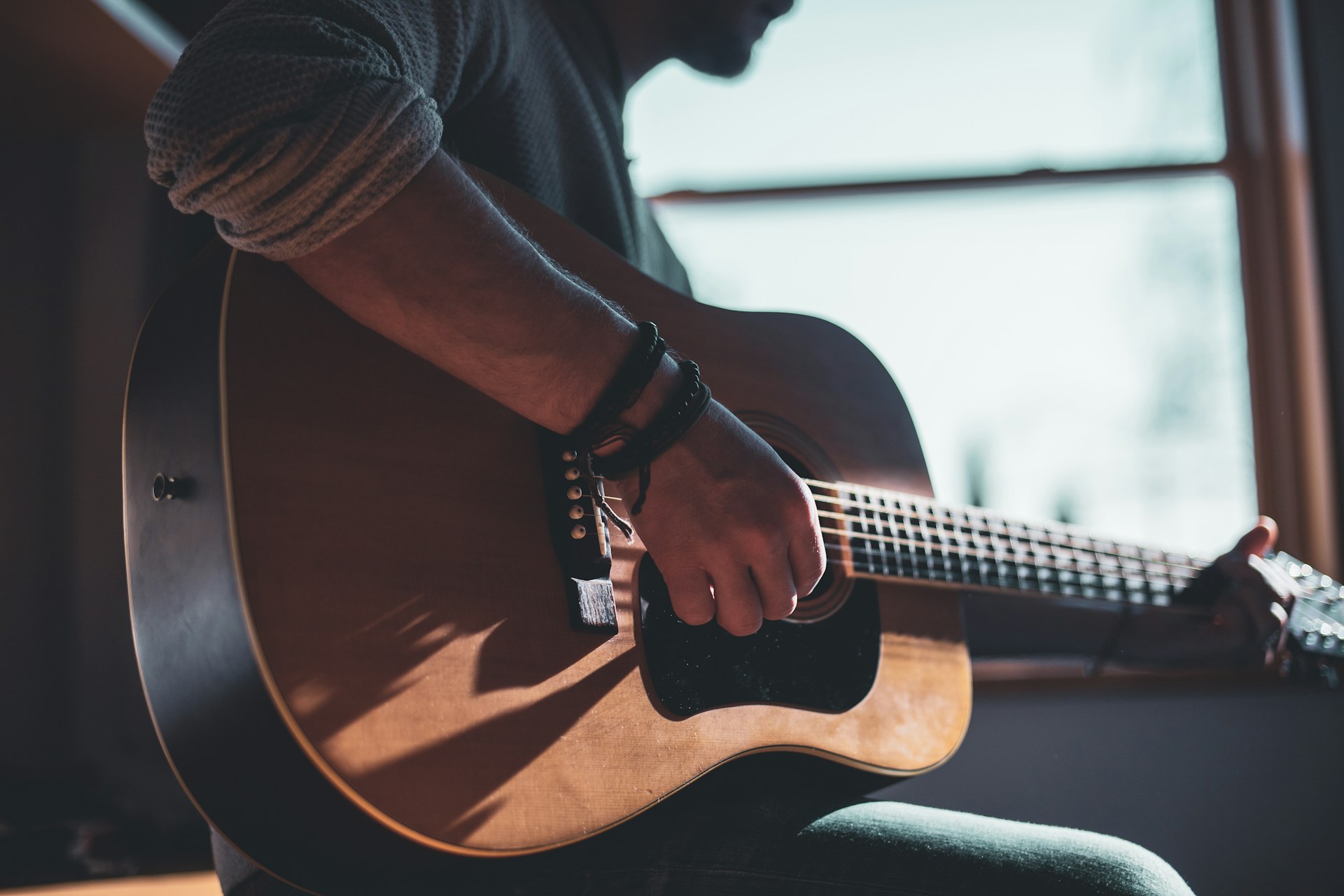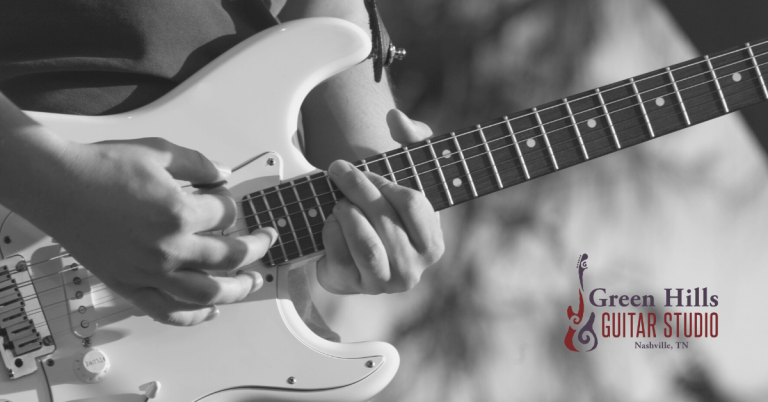Guitar Exercises for Synchronizing Both Hands
Coordination between the right and left hands is essential for smooth guitar playing. Whether you’re performing intricate solos, grooving on riffs, or strumming chords, synchronizing both hands ensures fluid, error-free playing. This coordination enhances technical proficiency and allows for better musical expression.
Many guitarists need help with hand synchronization, often finding that one hand lags or their playing lacks cohesion. This common challenge can hinder progress and limit musical potential. Fortunately, targeted practice and the right exercises can significantly improve hand coordination.
This article will explore exercises designed to enhance hand synchronization. From basic warm-ups to intermediate techniques, these exercises will help you develop the skills needed for more accurate guitar playing. Let’s dive in and synchronize those hands for a more polished sound!
Understanding Hand Synchronization
Guitar playing requires precise coordination between the right and left hands to achieve smooth and accurate execution of musical passages.
Hand synchronization refers to the ability of both hands to work together seamlessly, maintaining consistent timing, pressure, and movement across the fretboard and strings.
This skill is crucial for achieving a professional and polished sound in various playing styles, from classical to rock and everything in between.
Importance of Hand Synchronization
The synchronization of both hands is vital for several reasons:
- Precision and Accuracy: When both hands are synchronized, your playing becomes more precise, allowing you to hit the right notes with clarity and confidence.
- Speed and Efficiency: Synchronized hands enable faster playing, as there’s less wasted movement and more efficient energy use.
- Expression and Dynamics: Proper synchronization allows for more nuanced dynamics and expression in your playing, enhancing your ability to convey emotions through music.
- Reduced Tension and Fatigue: When your hands work together smoothly, you’re less likely to experience tension or fatigue, promoting better endurance during longer playing sessions.
Common Challenges in Hand Synchronization
Despite its importance, achieving hand synchronization can be challenging due to several factors:
- Timing Issues: One hand may need to catch up, resulting in a disjointed sound.
- Technical Coordination: Different techniques, such as alternate picking, fingerpicking, and chord changes, require varying levels of synchronization.
- Hand Independence: Each hand may develop at different rates, making it challenging to maintain equal proficiency.
Benefits of Improved Hand Coordination
Improving hand synchronization offers numerous benefits:
- Enhanced Technique: Better synchronization means cleaner technique, allowing for more complex and challenging playing.
- Greater Musical Versatility: You can confidently play various musical styles and genres.
- Confidence in Performance: With improved coordination, you’ll feel more confident and comfortable performing in front of others.
In the following sections, we’ll explore a series of exercises designed to help you develop and refine your hand synchronization skills.
By incorporating these exercises into your practice routine, you’ll be well on your way to achieving seamless coordination between your right and left hands.
Warm-Up Exercises
Effective warm-up routines for your right and left hands are crucial before diving into specific hand synchronization exercises. Warming up helps prevent injuries and primes your muscles and nerves for optimal performance.
These warm-up exercises are designed to improve blood flow, increase flexibility, and enhance the connection between your brain and muscles, setting the stage for successful practice sessions.
The Importance of Warm-Up Exercises
Warming up is essential for several reasons:
- Prevention of Injuries: Cold muscles are more prone to strains and injuries. Warming up gradually increases blood flow to your muscles, preparing them for the demands of playing guitar.
- Improved Technique: Warm-up exercises help you focus on correct hand positioning and movement patterns, setting a foundation for better synchronization during more complex exercises.
- Mental Preparation: Warming up allows you to mentally prepare for practice or performance, enhancing your concentration and focus.
Simple Warm-Up Routines
Finger Stretches and Hand Massages:
- Start by gently stretching your fingers, wrists, and forearms to improve flexibility and reduce tension.
- To warm up the joints, perform slow circular motions with each finger, clockwise and counterclockwise.
- Use your thumb to massage the base of each finger, applying gentle pressure to increase circulation.
Chromatic Scales
- Play chromatic scales slowly and evenly across all strings, focusing on using each finger in sequence (1-2-3-4) for both hands.
- Begin comfortably and gradually increase speed as your hands loosen up.
- Ensure each note is clear and distinct, maintaining even timing and pressure.
How to Incorporate Warm-Ups Into Your Practice Routine
- Duration: Spend 5-10 minutes warming up before starting more intensive practice sessions.
- Consistency: Make warming up a regular part of your practice routine, regardless of your playing level.
- Progression: Start with slow, basic exercises and gradually increase speed and complexity as your hands warm up and become more responsive.
Incorporating these warm-up exercises into your practice routine will prepare your hands effectively for the following synchronization exercises.
This foundation will help you achieve smoother and more precise coordination between your right and left hands, enhancing your overall guitar playing experience.
Basic Synchronization Exercises
Now that your hands are warmed up, it’s time to delve into basic synchronization exercises. These exercises will help you develop fundamental coordination between your right and left hands, focusing on timing, finger independence, and accuracy. These basics are crucial for building a solid foundation and progressing to more advanced techniques.
Exercise 1: Fingers 1-2 & 2-1
Objective: Improve right-hand picking accuracy and left-hand finger placement.
Instructions:
- Begin on the 6th string, ascending with fingers 1 and 2 and descending with fingers 2 and 1 while moving up chromatically.
- Use alternate picking (down-up strokes) to play this simple pattern.
- Focus on maintaining a steady rhythm and consistent picking technique.
Tips:
- Start at a slow tempo and gradually increase speed as you become more comfortable.
- Pay attention to the sound of each note and ensure they are clear and articulate.
- Use a metronome to maintain consistent timing and to track your progress.
Exercise 2: Fingers 2-3 & 3-2
Objective: Develop left-hand finger agility and coordination.
Instructions:
- Begin on the 6th string, ascending with fingers 2 and 3 and descending with fingers 3 and 2 while moving up chromatically.
- Use alternate picking (down-up strokes) to play this simple pattern.
- Focus on maintaining a steady rhythm and consistent picking technique.
Tips:
- Start slowly and gradually increase speed as you improve.
- Practice ascending and descending chromatic scales to improve both hands’ synchronization.
- Maintain a relaxed posture and hand position to avoid unnecessary tension.
How These Exercises Help
- Timing and Rhythm: These exercises improve your sense of timing and rhythm by focusing on alternate picking and consistent finger movements.
- Hand Independence: They help develop independence between your right and left hands, allowing you to play more complex patterns and melodies.
- Technical Foundation: Mastering these basic exercises builds a solid technical foundation, making progressing to more advanced techniques easier.
Incorporating Basic Synchronization Exercises Into Your Practice
- Practice Time: Allocate your practice routine to work on these exercises.
- Consistency: Regular practice is crucial in developing synchronization skills. Aim to practice these exercises daily or several times a week.
- Gradual Progression: Start at a slow tempo and gradually increase speed and complexity as you become more comfortable.
Focusing on these basic synchronization exercises will lay a solid groundwork for improving the coordination between your right and left hands. With consistent practice and attention to detail, you’ll soon notice improvements in your guitar playing, leading to smoother and more precise performances.
Intermediate Synchronization Exercises
Having mastered the basic synchronization exercises, it’s time to progress to more intermediate-level exercises.
These exercises will further challenge your right and left-hand coordination, incorporating more complex patterns and techniques.
By practicing these exercises, you’ll continue to improve your ability to synchronize both hands effectively, enhancing your overall guitar playing skills.
Exercise 3: Fingers 2-3-4-1 & 1-4-3-2
Objective: This picking exercise is the finger equivalent to a tongue twister. It uses an unconventional 2-3-4-1 and 1-4-3-2 finger pattern that is sure to help strengthen your fingers, build dexterity, and improve your alternate picking technique.
Instructions:
- Ascend using fingers 2-3-4-1 and descend using fingers 1-4-3-2.
- Use alternate picking (down-up strokes) to play this simple pattern.
- Focus on maintaining a steady rhythm and consistent picking technique.
Tips:
- Focus on maintaining even timing and finger pressure across both strings.
- Start slowly and increase speed gradually as you become more comfortable.
- Use a metronome to maintain a consistent tempo and improve accuracy.
Exercise 4: Fingers 3-4-1-2 & 2-1-4-3
Objective: Improve finger independence and accuracy in chord transitions.
Instructions:
- Ascend using fingers 3-4-1-2 and descend using fingers 2-1-4-3.
- Use alternate picking (down-up strokes) to play this simple pattern.
- Focus on maintaining a steady rhythm and consistent picking technique.
Tips:
- Focus on maintaining even timing and finger pressure across both strings.
- Start slowly and increase speed gradually as you become more comfortable.
- Use a metronome to maintain a consistent tempo and improve accuracy.
How These Exercises Help
- String Transitioning: These patterns help improve your ability to switch between strings smoothly and efficiently while increasing the strength and dexterity of each individual finger.
- Chord Transitions: Finger exercises enhance finger dexterity and accuracy in moving between chord shapes, which is crucial for more complex compositions.
- Technique Development: These exercises build on the techniques learned in basic exercises, refining your coordination and timing.
Check out this YouTube playlist for even more exercises meant to synchronize and strengthen your left and right hands.
Incorporating Intermediate Synchronization Exercises Into Your Practice
- Progressive Practice: Start with slower tempos and gradually increase speed as you become more comfortable with each exercise.
- Focused Practice: Concentrate on maintaining synchronization between your right and left hands, paying attention to accuracy and fluidity.
- Regular Practice Routine: Integrate these exercises into your regular practice routine to build consistency and track your progress.
Incorporating these intermediate synchronization exercises into your practice routine will strengthen your right and left-hand coordination skills. With persistence and dedication, you’ll develop a more polished and professional guitar playing technique, effectively tackling more challenging pieces and styles.
Tips for Effective Practice
Hand synchronization requires the right exercises and a strategic and disciplined approach to practice. Effective practice involves consistent, focused, and mindful repetition of exercises while maintaining a positive and patient attitude. Here are some essential tips to help you practice hand synchronization effectively and efficiently.
Consistency and Patience
Regular Practice Sessions:
- Set aside dedicated time for practice each day, even if it’s just 15-30 minutes. Consistency is vital to developing and retaining muscle memory.
Patience with Progress:
- Understand that improvement takes time. Be patient with yourself and recognize that small, incremental progress is still progress.
Setting Realistic Goals
Short-Term Goals:
- Break down your practice into manageable short-term goals. For example, aim to increase your playing speed by a small increment each week.
Long-Term Goals:
- Set long-term goals to keep you motivated. This could include mastering a particular song, improving speed, or perfecting a complex technique.
Recording Practice Sessions
Audio and Video Recording:
- Record your practice sessions regularly. Listening back or watching yourself play can help you identify areas for improvement that you might overlook in real time.
Progress Tracking:
- Keep a practice journal where you note what you practiced, any challenges you faced, and any progress you made. This will help you track your improvement over time and keep you motivated.
Metronome Practice
Use a Metronome:
- Practicing with a metronome helps you maintain consistent timing and rhythm. Start slow and gradually increase the tempo as your synchronization improves.
Tempo Variation:
- Practice at different tempos to challenge your coordination. Slow practice helps you focus on accuracy, while faster tempos build speed and endurance.
Focus on Relaxation and Posture
Proper Hand Positioning:
- Ensure that your hands and fingers are positioned correctly on the guitar. Proper positioning helps prevent strain and promotes better synchronization.
Relaxation Techniques:
- Stay relaxed while playing. Tension can hinder your ability to move your hands smoothly and precisely. Take breaks to stretch and shake out your hands.
Mindful Practice
Concentration:
- Stay focused on the task at hand. Avoid distractions and practice in a quiet environment where you can concentrate fully.
Mind-Muscle Connection:
- Be mindful of the movements and sensations in your hands. Developing a deep mind-muscle connection enhances your control and coordination.
Seeking Feedback and Guidance
Teacher or Mentor:
- Work with a guitar teacher or mentor who can guide, correct your technique, and offer personalized advice.
Peer Feedback:
- Play for friends or fellow guitarists and ask for constructive feedback. Sometimes, others spot issues that you might miss.
Balancing Athletic and Artistic Development
Technical Drills vs. Musical Application:
- Balance technical drills with playing actual music. Apply synchronization exercises to songs and pieces you enjoy to make practice more engaging and musical.
Creative Exploration:
- Experiment with different styles and techniques to keep your practice varied and interesting. This encourages creative growth alongside technical improvement.
By incorporating these tips into your practice routine, you’ll maximize the effectiveness of your synchronization exercises. Remember, effective practice is not just about the quantity of time spent but the quality of focus and intention behind it. Stay consistent, be patient with yourself, and enjoy the process of becoming a more synchronized and skilled guitarist.
10 Songs for Synchronizing Both Hands
Some suggested songs include challenging synchronization parts for practicing and improving hand coordination. These songs offer various genres and styles, allowing you to practice hand synchronization in different musical contexts.
- “Blackbird” by The Beatles (1968): The alternating bass and melody lines provide a good challenge for finger independence and synchronization.
- “Sultans of Swing” by Dire Straits (1978): Mark Knopfler’s intricate picking patterns and fluid solos are excellent for practicing hand coordination.
- “Tears in Heaven” by Eric Clapton (1992): The fingerstyle technique used in this song helps improve coordination between fingerpicking and fretting hand movements.
- “Neon” by John Mayer (2001): This modern song’s percussive fingerstyle technique and complex chord voicings are great for hand synchronization.
- “Scar Tissue” by Red Hot Chili Peppers (1999): The melodic, sliding lead parts and intricate picking patterns challenge hand synchronization and precision.
- “Get Lucky” by Daft Punk feat. Pharrell Williams & Nile Rodgers (2013): The funky rhythm guitar parts, characterized by tight, syncopated picking and clean chord changes, are excellent for practicing synchronization.
- “Tennessee Whiskey” by Chris Stapleton (2015): The smooth, bluesy licks and fluid fingerstyle play require precise hand coordination.
- “La Grange” by ZZ Top: The fast blues shuffle and solo parts offer an excellent synchronization exercise for rhythm and lead playing.
- “Shape of You” by Ed Sheeran (2017): The rhythmic strumming and percussive elements provide a modern pop context for practicing synchronization.
- “Sweet Child O’ Mine” by Guns N’ Roses: The famous intro riff and subsequent solo sections demand tight synchronization and timing.
The Coda
Mastering hand synchronization is crucial for any guitarist striving to achieve smooth, precise, and expressive playing. You can significantly improve the coordination between your right and left hands through targeted exercises, consistent practice, and mindful techniques.
From simple warm-ups to advanced drills and applying these skills in songs, the path to better synchronization is both challenging and rewarding.
Incorporating the exercises and tips discussed in this blog into your daily practice routine will lay a solid foundation for continued improvement. As you progress, your playing will become more fluid, your technical proficiency will increase, and your musical expression will flourish.
If you want personalized guidance to enhance your guitar playing skills, consider contacting Green Hills Guitar Studio. Whether in Nashville, TN (or anywhere in the world!), we offer comprehensive guitar lessons tailored to your needs.
Our experienced instructors can help you refine your technique, develop your musicality, and achieve your guitar-playing goals. Contact us today to schedule your lesson and take the next step on your musical journey!






